Ngong Racecourse #3: Aamazing Aardvark!
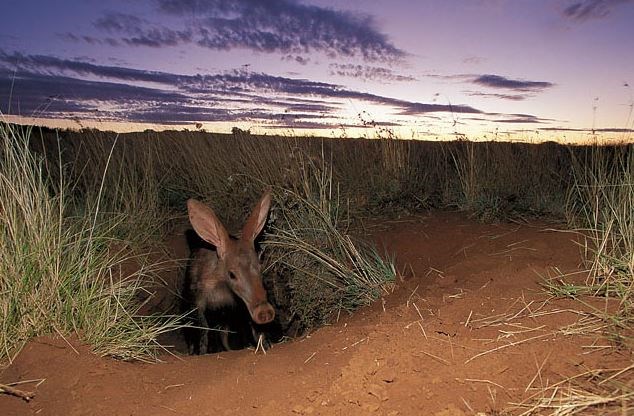 The cache, a small tablet pot, is hidden in a hole above head height in the more southern of the two largest and probably oldest trees in this area of the lovely shady and secluded part of the Ngong Forest just adjacent to the racecourse.
The cache, a small tablet pot, is hidden in a hole above head height in the more southern of the two largest and probably oldest trees in this area of the lovely shady and secluded part of the Ngong Forest just adjacent to the racecourse.
To reach the cache location: take the main Ngong Road from central Nairobi as far as the racecourse access road at S 01 18.391 E 36 44.338. Pass through the entry/security gate (no charge) and proceed ahead to the parking area. If you wish to do the multi-cache GC5G47P Ngong racecourse #1: Familiarisation first then park @ S 01 18.714 E 36 44.523 near the steps accessing the racecourse grounds. Otherwise continue towards the cache location and park as close as you can at the end of the main access dirt road @ S 01 18.781 E 36 44.631 near the location of GC5G5R5 Ngong Racecourse #2: Some History. Don't drive beyond this point as there is no suitable parking place.
Proceed on foot further along the jeep track running alongside the forest edge until @ S 01 18.858 E 36 44.802 you will find an opening and the start of a small trail heading down into the forest. Follow this trail the 100m or so to the cache location. There is no charge for accessing the area where this cache is hidden.
Note: although there have been security incidents in Ngong Forest in the past, these were in areas well away from the racecourse. Security has also been increased with the introduction of additional rangers and the ongoing development of the Ngong Forest Sanctuary as a secure recreational area. See here for more information on the Sanctuary
As I entered the forest to look for a cache hiding place, there was considerable rustling - I spotted a troop of Syke's monkeys moving off through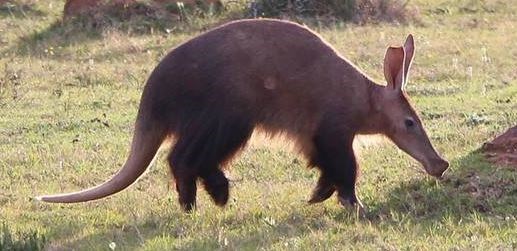 the canopy then caught a brief sight of a dikdik disappearing into the bush lower down the slope. En route to the cache location I also passed two large and fresh burrows, further evidence that the forest is full of life . . . and full of . . . aardvarks!
the canopy then caught a brief sight of a dikdik disappearing into the bush lower down the slope. En route to the cache location I also passed two large and fresh burrows, further evidence that the forest is full of life . . . and full of . . . aardvarks!
So enter and move through the forest quietly and you may catch sight of some of the forest creatures before they spot you and disappear.
The last survivor of a group of primitive ungulates, Orycteropus afer is a medium-sized omnivore which lives up to 23 years in the wild. Weighing 50-82kg, its head and body is 109-135cm with a tail of 53-66cm. It lives up to 3,200m in savanna, grassland, woodland, bushland (but not swamp or rocky areas) in Africa, south of the Sahara
It looks a bit like a pig, with rabbit ears and a kangaroo tail - yet is related to none of these - one of its closest relatives is the elephants.
The name is Afrikaans for 'earth or ground pig or hog'- they are also called 'antbears' or 'anteaters'.
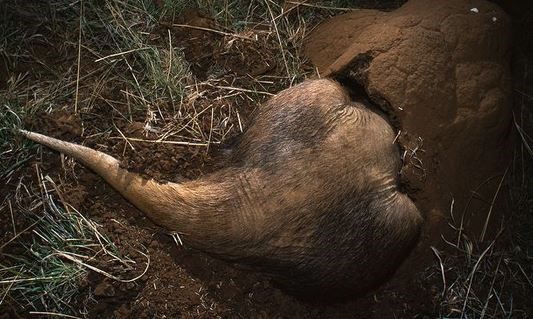 They are nocturnal and after sunset leave their cool burrows to forage over 10-30 km in grasslands and forests for their favorite food - ants and termites - swinging their long nose from side to side to pick up the insects' scent.
They are nocturnal and after sunset leave their cool burrows to forage over 10-30 km in grasslands and forests for their favorite food - ants and termites - swinging their long nose from side to side to pick up the insects' scent.
They use their powerful spade-like feet and claws for fast digging of underground burrows and digging up large termite mounds to feast on the insects inside. Their tough thick skin protects them from bites whilst their long (up to 30cm), sticky, wormlike tongue can trap up to 50,000 termites and ants in one night! An unusual but useful ability allows it to seal its nostrils to keep dust and insects from invading its snout.
The aardvark swallows its food whole, grinding it up in a muscular area of its lower stomach instead of chewing.
Its keen hearing warns it of predators such as lions, leopards, hunting dogs, hyenas, and pythons. If they need to escape, they dig fast or run in zigzags. If that fails, they will strike with their claws, tail and shoulders, sometimes flipping onto their backs to lash out with all fours. If attacked 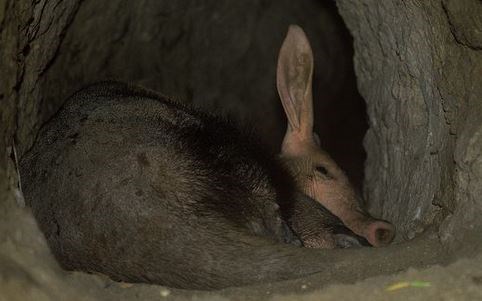 in the tunnel, they dig further in sealing the tunnel off behind or turn around and attack with their claws.
in the tunnel, they dig further in sealing the tunnel off behind or turn around and attack with their claws.
Main burrows up to 13m long are used for breeding, can be deep and extensive, and have several entrances. Solitary animals, they change their home burrow layout regularly, and from time to time move on and make a new one. Old burrows are an important part of the African wildlife scene as once vacated, they are inhabited by smaller animals like the African wild dog, ant-eating chat, and warthog. Other animals that use them are hares, mongooses, hyenas, owls, pythons, and lizards. Without these refuges many animals would die during wildfire season.
Mainly solitary, it is only occasionally seen with other individuals, such as when mating and when a young accompanies its mother. The female gives birth to a single naked young after 7-9 months gestation. The young aardvark will remain in the burrow for about 2 weeks before starting to accompany its mother on night time  foraging trips. By the age of 6 months, the young can dig for itself, and by 12 months it has reached full size. Sexual maturity is reached at about 2 years old.
foraging trips. By the age of 6 months, the young can dig for itself, and by 12 months it has reached full size. Sexual maturity is reached at about 2 years old.
The aardvark is admired in African folklore because of its diligent search for food and its lack of fear of soldier ants. Hausa magicians make a charm from the heart, skin, forehead, and nails of the aardvark, which is pounded together with a special tree root. Wrapped in a piece of skin and worn on the chest, the charm is said to give the owner the ability to pass through walls or roofs at night. It is said to be used by burglars and those seeking to visit young girls without their parents' permission! The meat, which is similar to pork, is eaten in certain cultures.
The Egyptian god Set has the head of an aardvark.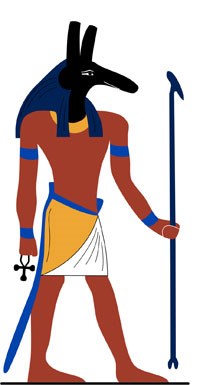
The titular character of Arthur, an animated children's TV series, shown in more than 180 countries, is an aardvark.
See here for lots more fascinating information on this weird and wonderful creature.
See here for a charming video of a mother and baby at Brookfield Zoo, Chicago
See here for a video of an aardvark busily foraging in the wild